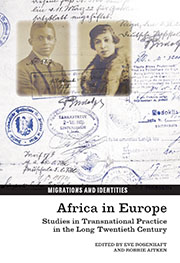Book contents
- Frontmatter
- Contents
- Acknowledgements
- List of Illustrations
- List of Abbreviations
- List of Contributors
- 1 Introduction
- I Enacting Identity: Individuals, Families and Communities
- II Authenticity and Influence: Contexts for Black Cultural Production
- 6 Féral Benga's Body
- 7 ‘Like Another Planet to the Darker Americans’: Black Cultural Work in 1930s Moscow
- 8 ‘Coulibaly’ Cosmopolitanism in Moscow: Mamadou Somé Coulibaly and the Surikov Academy Paintings, 1960s–1970s
- 9 Afro-Italian Literature: From Productive Collaborations to Individual Affirmations
- III Post-colonial Belonging
- IV Narratives/Histories
- Bibliography
- Index
7 - ‘Like Another Planet to the Darker Americans’: Black Cultural Work in 1930s Moscow
from II - Authenticity and Influence: Contexts for Black Cultural Production
- Frontmatter
- Contents
- Acknowledgements
- List of Illustrations
- List of Abbreviations
- List of Contributors
- 1 Introduction
- I Enacting Identity: Individuals, Families and Communities
- II Authenticity and Influence: Contexts for Black Cultural Production
- 6 Féral Benga's Body
- 7 ‘Like Another Planet to the Darker Americans’: Black Cultural Work in 1930s Moscow
- 8 ‘Coulibaly’ Cosmopolitanism in Moscow: Mamadou Somé Coulibaly and the Surikov Academy Paintings, 1960s–1970s
- 9 Afro-Italian Literature: From Productive Collaborations to Individual Affirmations
- III Post-colonial Belonging
- IV Narratives/Histories
- Bibliography
- Index
Summary
By the late 1920s, the Soviet Union and the Communist International had identified culture as a major battleground in the struggle for Bolshevik dominance at home and proletarian revolution abroad. One facet of this effort was the development of anti-colonial cultural work that spoke to audiences around the globe. Soviet playwright Sergei Tretiakov's indictment of Western indifference to colonial suffering, Roar, China! (1926), was staged to great acclaim in Moscow, Berlin and New York. The classic dramatisation of anti-imperial revolt in Central Asia, Storm over Asia (1928), was an international sensation; among its many screenings across the globe, Indian students at Oxford University showed the film as a prelude to a debate on the importance of the Soviet experiment for colonial revolutionaries. When the anti-fascist Soviet documentary Abyssinia (1936) – a protest film that took aim at Mussolini's 1935 invasion of Ethiopia – came to play in Shanghai, Italian seamen rioted in the theatre to object to the criticism of their homeland, much to the amusement of colonial comrades. These works, along with dozens of similar productions, linked the problems of capitalism, colonialism and racism, positing Communist revolution as their solution.
Soviet screenwriter G. E. Grebner contributed to this international cultural front in 1930, when he drafted Black and White (Chernyi i belyi), an ‘anti-Ku-Klux-Klan’ story based on the author's autodidactic study of American race relations. According to the script's preface, Grebner hoped not only to produce a broadside against racial terror in the United States, but also to counter anti-black stereotypes rampant in American and European film, presenting, he said, ‘Negroes on screen as humans, for the first time’.
- Type
- Chapter
- Information
- Africa in EuropeStudies in Transnational Practice in the Long Twentieth Century, pp. 120 - 141Publisher: Liverpool University PressPrint publication year: 2013



